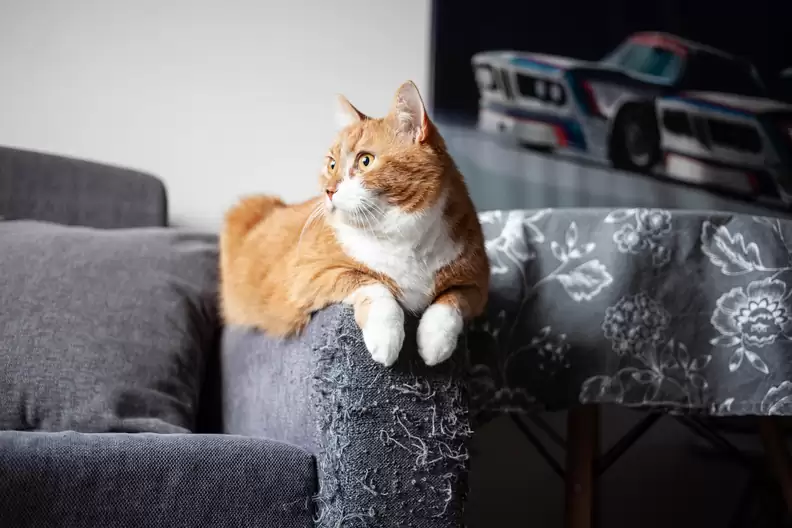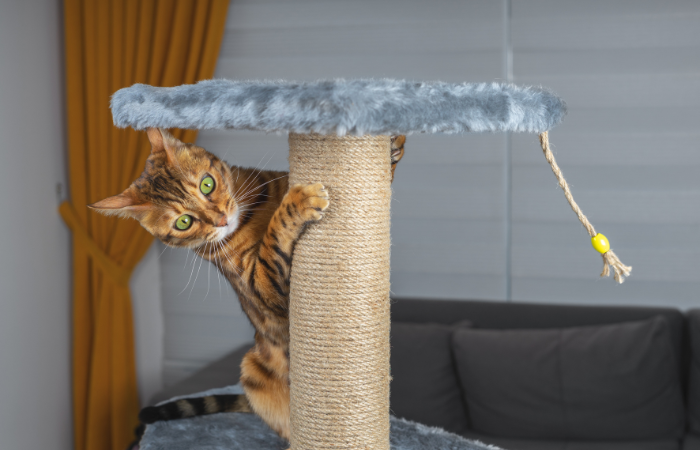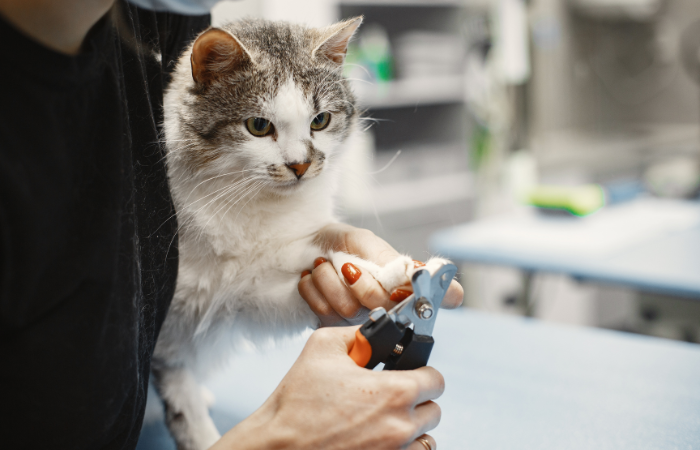Ah, cats and couches—a tale as old as time. If you’ve ever walked into your living room to find your beloved feline turning your furniture into a scratching masterpiece, you know the struggle. One moment, they’re purring sweetly on your lap; the next, they’re shredding your sofa like they’re auditioning for a furniture destruction competition.

When Luna, my sassy tabby, decided my couch was the perfect scratching canvas, I knew I had a problem. Every time I walked into the room, I’d find her mid-scratch, locking eyes with me as if to say, “What? This couch belongs to me now.” It took some trial and error, a little creativity, and a lot of catnip, but we’ve finally reached a truce. Here’s how you can save your couch without losing your mind—or your cat’s affection.
1. Understand the Scratch Obsession
Before you go full Sherlock on why your cat is ruining your couch, know this: scratching is not an act of defiance—it’s a biological necessity. Cats scratch to stretch, mark territory, and keep their claws healthy. It’s part of their instinctual charm… even if it’s terrible for your furniture.

Why Cats Scratch:
- Marking Territory: Cats have scent glands in their paws, and scratching lets them leave their “I was here” mark.
- Stretching and Flexing: Scratching doubles as a yoga workout for their muscles.
- Shedding Old Claw Layers: Think of it as a manicure, cat-style.
Understanding this helps you redirect their scratching rather than trying to stop it altogether. Trust me, fighting nature is a losing battle.
2. The Great Scratching Post Swap
The easiest way to save your couch? Give your cat something better to scratch. A sturdy, irresistible scratching post is a must.

How to Pick the Perfect Scratcher:
- Material Matters: Sisal rope, carpet, or cardboard are cat favorites.
- Go Vertical (or Horizontal): Some cats prefer tall posts to stretch out, while others like flat scratchers. Let them pick!
- Location, Location, Location: Place the scratcher near the couch to make it a convenient alternative.
Luna’s Choice: I tried three different scratchers before she decided that a catnip-infused cardboard one was her true love. Once she claimed it, my couch got a much-needed break.
3. Make Your Couch Unappealing
Cats are smart—if your couch is no longer fun to scratch, they’ll look elsewhere. The trick is to make the couch a scratching no-go without turning your living room into a cat-proof fortress.

Couch-Defense Tools:
- Double-Sided Tape: Cats hate sticky surfaces, so applying tape to their favorite scratching zones can deter them.
- Scratch Guards: Clear plastic shields stick to the sides of your couch, protecting it from claws while blending in with your decor.
- Furniture Covers: A thick, washable cover can protect your couch until your cat develops better habits.

Luna’s Reaction: I put double-sided tape on her go-to couch corner. One touch and she leapt back like it had personally betrayed her. She hasn’t touched that spot since.
4. Distract with Toys (and Catnip)
Sometimes, cats scratch out of boredom or because they’re looking for attention. Keeping them entertained can prevent them from turning your couch into their personal project.

How to Distract Your Cat:
- Interactive Toys: Wand toys, feather teasers, or laser pointers can tire them out and redirect their energy.
- Catnip or Silvervine: Sprinkle some on their scratching post to make it irresistible.
- Playtime Sessions: Regular play helps burn off extra energy and reduces destructive behavior.

Luna’s Distraction Plan: A feather wand is her kryptonite. After a 10-minute play session, she’s too tired to care about the couch.
5. Keep Those Claws in Check
Regular claw trimming can reduce the damage if your cat does sneak a swipe at your couch. Plus, trimmed claws are healthier for your cat!

Claw Care Tips:
- Use cat-specific nail clippers for a clean cut.
- Start slow if your cat isn’t used to trims—maybe just one or two claws at a time.
- Reward them with treats or extra cuddles afterward to make it a positive experience.
Luna’s “Spa Day”: She tolerates claw trims if I bribe her with tuna. No bribe? No chance.
6. Try Scent-Based Deterrents
Cats are picky about smells, and some scents can be used to keep them away from your couch without bothering you.
Cat-Repellent Scents:
- Citrus: Most cats can’t stand the smell of oranges or lemons. Spritz a cat-safe citrus spray near the couch.
- Herbs: Rosemary and lavender are also natural cat deterrents.
- Vinegar: A diluted solution can work wonders, though it might not be your favorite scent either.
Luna’s Sniff Test: One whiff of a citrus spray, and she looked at me like I’d betrayed her entire family. Effective, but dramatic.
7. Reward the Good, Ignore the Bad
Cats are surprisingly trainable—if you know how to speak their language. Positive reinforcement works wonders for teaching them new habits.

How to Reinforce Good Behavior:
- Give treats or affection when they use their scratching post.
- Avoid punishing them for scratching the couch—it’ll only confuse or stress them.
- Be consistent. Every scratch post success deserves a celebration!
Luna’s Reward System: She now runs to her scratching post every time I pick up her treat jar. A little bribery goes a long way.
8. Be Patient and Persistent
Training a cat to leave your couch alone isn’t an overnight process. It takes time, consistency, and a lot of love (plus a little humor when they inevitably ignore your efforts the first few times).

Remember:
- Cats are creatures of habit—it might take a few weeks to see real progress.
- Celebrate small victories, like the first time they choose the scratcher over the couch.
- Your bond with your cat is more important than your furniture. With patience, you can have both!
Luna’s Final Test: After a month of training, Luna now prefers her scratcher. The couch is safe, and she gets all the head scratches for being the good girl she is.
Final Thoughts: Couch Peace is Possible
Protecting your couch from your cat doesn’t mean picking sides. With the right tools, a little creativity, and plenty of patience, you can save your furniture and keep your cat happy. From irresistible scratching posts to citrus sprays and a little treat-based persuasion, there’s a solution for every feisty feline.

For Luna and me, a combination of tape, catnip, and positive reinforcement turned our living room from a war zone into a cozy, cat-friendly space. Now, she lounges on the couch instead of clawing it, and we’ve never been better friends.
Have your own tips or funny couch-saving stories? Share them—I’d love to hear how you and your cat reached a truce in the battle of the furniture! 🐾


